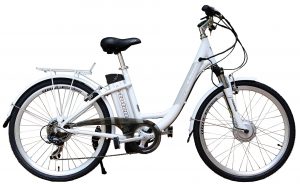Summer is coming and the e-bikers are on their way again. In 2018, approximately 980,000 e-bikes were sold in Germany and the trend is increasing. E-bikes are simply comfortable, now affordable and offer a whole new cycling experience.

BUT: Lithium batteries are also used in e-bikes. Lithium batteries are small, lightweight and efficient. They are mainly used in devices such as notebooks and mobile phones, but also in battery-powered vehicles such as electric bicycles.
A bicycle battery consists of 30-40 battery cells. If only one of these cells is defective, the resulting heat generation sets a chain reaction in motion – the stored energy is instantly released, sparks are generated and set the battery on fire.
“The number of fires increases with the number of lithium batteries. This is no reason to demonize this design, but we should all be aware of the risk,” says Dr. Hans-Hermann Drews, Managing Director of the Institute for Loss Prevention and Damage Research (IFS).
Here is a very descriptive video about the danger of lithium batteries.
These are some rules you should follow to reduce the risk of fire:
-
Only use the charger recommended by the manufacturer.
-
Avoid extreme temperatures or wetness – this means that even a cold garage is not a suitable place to winter your bicycle battery. Store the battery in a cool, dry place with about 60% of the charge capacity.
-
The battery takes about ten minutes to adapt to the room temperature, otherwise it can inflate and ignite during charging.
-
Since the majority of fires occur during the charging period, you should charge the batteries in a room with a smoke detector, ideally on stone floors and out of reach of flammable materials, or outside in a weather-protected place.
-
To avoid overloading, chargers should not be operated from multiple sockets.
If you discover any damage to the battery, it must never be used again. After a fall, for example, e-bike riders should have the battery checked as a precaution.
-
Unlike normal bicycles, e-bikes must carry a CE mark. This indicates that the manufacturer has complied with all applicable regulations during production and that the battery complies with the EU standard. This means that batteries are protected against overcharging, deep discharge, short circuits, extreme temperatures and vibrations. Accordingly, the Allgemeine Deutsche Fahrrad-Club (ADFC) advises to classify pedelecs without this symbol as unsafe and to avoid them. In addition, experts recommend that when purchasing electric bicycles, the GS seal (stands for tested safety) should be observed, which indicates high product safety requirements.
-
If you do not use your e-bike for a long time, you should clean the bike and connection carefully. First charge the battery only half and then check the battery level every four weeks and recharge if necessary. If the e-bike is left unused in the basement for a longer period of time, the battery may be deeply discharged. Often ten weeks are enough and the battery is damaged. This increases the risk of the battery catching fire.
-
Charging stations in public places or in front of hotels are also ideal for refuelling.
Important, in case something really happens: Lithium reacts with water, so fires triggered by Li-Ion batteries should only be suffocated with sand or blankets.
The Institut für Schadenverhütung und Schadenforschung e. V. was founded in 1976. It goes back to the Fire Prevention Laboratory, which was founded in 1884 by the Schleswig-Holsteinische Lan-desbrandkasse. Today, the association with headquarters in Kiel has nine locations nationwide. A team of natural scientists and engineers investigates in the emphasis fire and fire damages, tap water and humidity damages. The findings from the cause investigations serve the general prevention of damage and are made accessible to the public.
